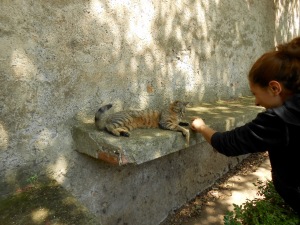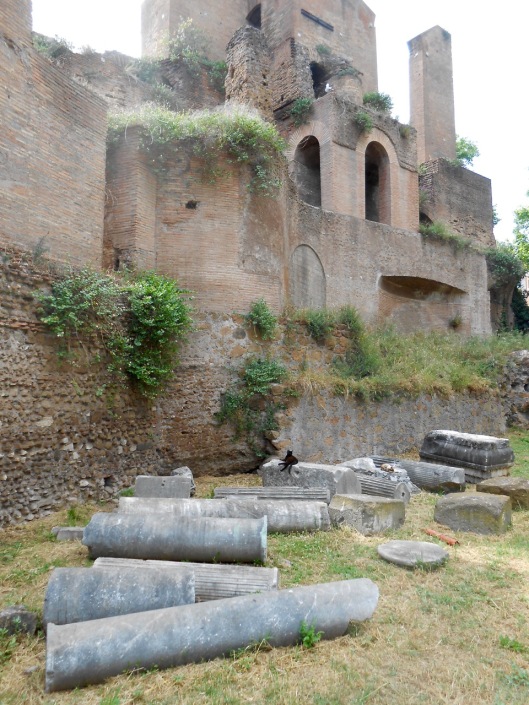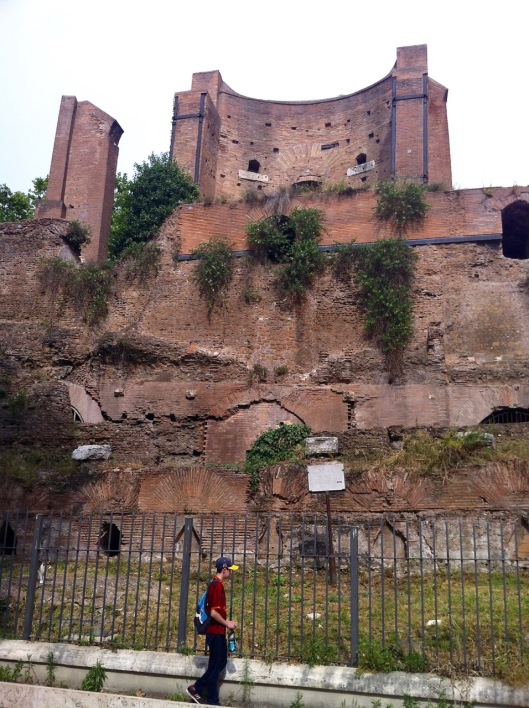I’m not cheating and this is no Bernini, but I may have found a distraction here in the good ole USA… chiseled in 1939 by artist James L. Hansen, there’s a copy in DC and in the LA Federal Courthouse. He’s been dubbed “Honest Abs!”

12 Tuesday Mar 2019
Posted in Uncategorized
I’m not cheating and this is no Bernini, but I may have found a distraction here in the good ole USA… chiseled in 1939 by artist James L. Hansen, there’s a copy in DC and in the LA Federal Courthouse. He’s been dubbed “Honest Abs!”

13 Monday Jun 2016
Posted in Fun Facts, History, Italian History, Italian Life, Rome, Things I Love, travel
Tags
architecture, Cat Shelters, Cats, History, Italian History, Italy, Rome, secrets of rome, Travel

This kitty howled his hello!
As an avowed (some would say obsessed) cat-lover living in Italy for a year without my beloved Bella, a Siamese with a wicked purr and sharp blue eyes, I’ve had to find cat love where I can.

My Bella
Fortunately, in Rome, cats are everywhere you look. In the Colosseum…

Guarding their owners’ cars…

Even in bathrooms in Trastevere bars, and on benches in the Jewish ghetto….

Art in a bar bathroom in Trastevere

Ghetto bench
But many cats have taken up residence in some of the Eternal City’s most historic spots, so you can be a tourist and a cat-lover at the same time.
According to the latest animal census commissioned by the Italian office of animal rights, there are about 300,000 cats in Rome, 120,000 of them live in cat colonies or are feral on the streets.
Cats are so popular in Rome that a local law stipulates that a group of more than five cats in a natural, urban habitat constitutes a protected cat colony, where the furry felines are entitled to food and shelter. Volunteers—in the past they were usually women known as “gattare”—see that the cats are cared for. There are approximately 4000 cat colonies in Rome today, but three of the most accessible are smack in the center of history.

Piramide cat colony
Cats in ancient Egypt were considered sacred, so it’s fitting that Rome’s most scenic cat sanctuary sits in the shadow of the imposing pyramid that looks down over the Protestant cemetery of Rome, on a quiet street in the Testaccio neighborhood. A beautiful oasis from the chaos of the city, the cemetery is the resting ground for many of Italy’s most famous ex-pats, including John Keats and Percy Bysshe Shelley.

Cemetery cat
With its narrow aisles, colorful flowers, and sculptured tombs, it’s an ideal playground for cats. One tiger-striped kitty named Miccio certainly looked happy as a volunteer named Giulia gave him a neck rub and prepared to feed some of the other 40-plus cats that call the site home.

Giulia, a volunteer at Piramide’s cat sanctuary
Giulia told me that for centuries cats have enjoyed romping through the cemetery and curling up in the shade of the 118-foot-high ancient pyramid, built around 18 BC by Roman magistrate, Gaius Cestius, as a monumental tomb for his family. Adding to the scenic history, in the 3rd century, the Aurelian Walls were erected right around it.
The current cat sanctuary began in 1984 with one volunteer, Matilde. Horrified by how many cats around the pyramid were sick and mistreated, she lobbied to set up a true shelter on the grounds. Despite initial reluctance by local officials, the colony’s growing number of volunteers continued to feed the cats and strove to find vets to treat and sterilize them. The Villa Andreina, a pet boarding organization, eventually helped out with food and medical care and even donated little wooden houses as shelter.

Aurelian Walls flank the pyramid
Now the colony, run by a volunteer association for the protection and care of cats in Rome, is thriving and participates regularly in adoption events. Cat lovers can visit Miccio and his friends daily between 2 and 4 p.m. and donations are accepted on the website.

A kitten among the cat shelters
Via del Campo Boario, 1, near Piazzale Ostiense

Piazza Vittorio Emanuelle
The site of the cat colony at Piazza Vittorio Emanuelle II in Rome, in the Esquilino neighborhood behind Termini train station, feels a lot like the surrounding streets—gritty, diverse, a little rundown, and fiercely independent.

Lazy cats
The cats laze around the Trofei di Mario, the ruins of a monumental fountain dating from 226 BC, in a corner of the park behind a fence that also protects the “Porta Magica” or Magic Gate (behind the lamppost above), the only remaining piece of the grand Villa Palombara that once stood on the site.
The park is best visited during the day and if you arrive in mid-afternoon, around the time schools let out, you might be lucky enough to see one of the colony’s most dedicated volunteers—a boy named Sammi.

A boy feeds the cats
As I snapped photos of the cats, I heard someone whistling. And then I saw a boy of about 14, with a backpack and wearing a Roma football jersey, walk up to the fence, still whistling. The cats came running from all directions. The boy pulled a bag of cat food from his backpack, shooed away the pigeons that came flying in and put little mounds of cat food down, petting the cats and protectively watching over them as they ate.

A dedicated volunteer

A hungry cat
Sammi shyly said he comes every day to feed the cats, of which there are 40 or 50, but unlike the Piramide cats, they’re mostly abandoned and their care isn’t officially organized. Still, Sammi clearly loves them—he said his family has cats at home that he first met in the park.
After the cats on one side of the enclosure ate their fill, Sammi walked around the fence, still whistling, and went to greet the felines on the other side.
Trofei di Mario, Piazza Vittorio Emanuelle II, northwest corner; for information on visiting the Trofei di Mario tel. +39-060608.

Welcome to the Argentina sanctuary!
The Torre Argentina Sanctuary, a no-kill shelter, is easily the most organized in Rome. Here, up to 120 cats loll on the marble slabs and chunks of broken walls of the one of the most ancient temples in Rome—the site where on the Ides of March Julius Caesar was brutally stabbed.

Cats in the ruins

Italian actress Anna Magnani
Cats took up residence here beginning in 1929, while excavations were underway.
The Gattare fed the cats, including Italian film star Anna Magnani, who would visit her furry friends on breaks from working at the nearby Teatro Argentina.
Now, down a set of metal stairs, you’ll find a couple of rooms with low ceilings where the volunteers of this sanctuary care for the cats, and where many of their furry friends sleep in cozy beds, play with toys and greet visitors with a loud meow.

Cats inside the Argentina shelter make themselves at home.
Recently, I had the privilege of meeting Silvia Viviana, the president of the Torre association that has been caring for the cats since 1993. A former opera singer who still exudes the gravitas—with her sweep of silver hair and long black dress—that she no doubt projected from the stage, Silvia told me that 25 years ago she used to walk by the area and watch the cats frolicking in the ruins.
She assumed they were being cared for. But one day she discovered that a lone, elderly lady was feeding the furry beasts and she decided to help. “Well, I offered to come and open the cans,” she said, especially after the older lady broke her leg and couldn’t feed them any more.

Cats on the stairs of Largo Argentina
Like the cats at Piramide and elsewhere, many were sick, pregnant, and needed vet care. Silvia took action. She convinced vets to offer their services for free. Since then, it’s been her mission—along with a slew of volunteers—to feed, care for and find homes, when possible, for the Argentina cats. “No cat leaves here who isn’t spayed or neutered,” she said emphatically. In 2015 alone, the Argentina shelter saw that 4,852 cats were sterilized and 142 cats found good homes.

If you want to adopt a Roman cat, this is a good place to look. But you have to pass Silvia’s inspection—the volunteers always try to make sure the cats go to a good, caring home—Silvia has two of her own from the shelter. While some cats have been adopted by foreign visitors, she says countries like America have so many needy animals of their own, that they don’t actively encourage foreign adoption. But the Torre sanctuary does encourage donations, which can be made on their website (romancats.com).

Laura has been volunteering at the shelter for years
The shelter is supported only by donations and volunteers, like seven-year veteran Laura, who greets visitors with a smile and any information you might want on the cats who wander freely through the shelter, up the stairs and out into the ruins, delighting tourists when they stop to say hello.

Virgola as a kitten
My personal favorite—a little guy I was tempted to adopt!—is named Virgola, which means “comma” in Italian. I first met him a few months ago when he was a kitten. These days he’s almost fully grown, and while he hasn’t been adopted yet, he seems pretty happy to snooze away under the watchful eyes of his dedicated and loving caretakers.
Via Florida & via di Torre Argentina; open noon-6 p.m. daily; Ph: +39-06-68805611

Virgola in June, all grown up but soooo sleepy!
14 Sunday Feb 2016
Posted in Art History, Bernini, Italian History, Rome, Uncategorized
Tags
art history, Baroque, Bernini, Gian Lorenzo Bernini, Italy, Rome, Travel

Bernini self-portrait, completed when he was in his twenties.
…and to all the tortured lovers out there (and those of us who are still searching)!

The Ecstasy of Saint Teresa, from Santa Maria della Vittoria church, Rome.

Bernini’s Pluto and Proserpina, Galleria Borghese, Rome.